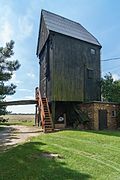List of cultural monuments in Selben
The list of cultural monuments in Selben includes the cultural monuments of the Delitzsch district of Selben , which were recorded by the State Office for Monument Preservation of Saxony until April 2020 (excluding archaeological cultural monuments). The notes are to be observed.
This list is a subset of the list of cultural monuments in Delitzsch .
The same
| image | designation | location | Dating | description | ID |
|---|---|---|---|---|---|
 More pictures |
Church with equipment | Great Village Road (map) |
Late 15th century / early 16th century | Small late Gothic hall church with a tower-like roof turret, architecturally and historically of interest. Tower-like roof turret above the west gable with a high, pointed pyramid roof, plastered field stone building in the west gable with intricate brick, choir is only slightly drawn in and closed on three sides, pointed arched windows, hall with later basket arched windows, remnants of the original plastered structure have been preserved.
Inside, barrel vaults and fittings, wooden galleries on three sides, in the north choir wall a pointed arched sacraments niche made of sandstone with tracery framing and coats of arms (around 1500), baroque pulpit altar made of wood (around 1700), plastic additions (early 19th century). Predella with oil painting: Last Supper, full columns that carry a tail gable with an openwork tympanum, the basket with twisted columns, in the arched niches oil paintings with depictions of Moses, the burial, crucifixion and resurrection of Christ and John the Baptist. Classicist vase-shaped wooden baptism with fluting and garland, the tin baptismal font marked 1817, organ with a large, classicist prospect, pilaster structure and latticed veil with rosettes (around 1820). Today ruinous condition, cracks in the masonry. |
08972214 |
| Former parsonage with enclosure | Grosse Dorfstrasse 13 (map) |
Mid 19th century and later | Striking building with largely original structure, of architectural and settlement historical importance. Two-storey, five-axis plastered clay building, gable made of brick masonry, gable roof with protruding wooden eaves, design using colored plaster strips, pilaster strips and bezels, two-sided coffee cornice covered with beaver tail. Original: wooden walls in the portal, old shutters on the ground floor. The plastered area around the portal can still be seen, the sills made of plastered brick. |
09257101 |
|
| House of a farm | Grosse Dorfstrasse 20 (map) |
Around 1800 | Two-storey clay building with a crooked hipped roof, authenticity and original building fabric preserved, of importance in terms of building history and settlement history. Plastered, hipped roof with crown covering, plaster structure in the form of contrasting and colored cornice strips, garments and fascias. Still original: windows, portal, plaster. |
09257088 |
|
| Moving house, side building, courtyard wall and gate entrance of a three-sided courtyard | Kleine Dorfstrasse 4 (map) |
Marked 1896 (stable barn) | Clinker buildings, typical evidence of the Wilhelminian era, their gables are prominently protruding for the visual relationship with the village street and characterize the street space and are of importance in terms of building history. The farmhouse, which was demolished before 2010, was one of the few surviving examples from the early 19th century in the village.
|
08972213 |
|
| Gravestones in the cemetery | Lange Strasse 97 (map) |
Inscribed with 1848 (tomb); marked 1870 (tomb) | Several high-quality grave monuments in sandstone, of artisanal, artistic and local significance.
|
08972216 |
|
 More pictures |
Post mill with mill technology | Zschortauer Strasse 28 (map) |
1753 | Windmill built around 1753 with technical equipment from the first third of the 20th century with a motor drive, in operation until 1996, of technical historical importance and impact on the townscape.
Mill without rods, electric drive, operated with wind power until 1933, rods dismantled in 1933, drive between 1933 and 1938 with diesel Deutz engine, from 1938 with an electric motor, still used for grinding until 1996, very well preserved condition. Technical equipment: grinding mill, grist mill, roller mills, cleaning, throw sifter, squeezer and peeling machine for pearl barley. |
08972218 |
Remarks
- This list is not suitable for deriving binding statements on the monument status of an object. As far as a legally binding determination of the listed property of an object is desired, the owner can apply to the responsible lower monument protection authority for a notice.
- The official list of cultural monuments is never closed. It is permanently changed through clarifications, new additions or deletions. A transfer of such changes to this list is not guaranteed at the moment.
- The monument quality of an object does not depend on its entry in this or the official list. Objects that are not listed can also be monuments.
- Basically, the property of a monument extends to the substance and appearance as a whole, including the interior. Deviating applies if only parts are expressly protected (e.g. the facade).
swell
- Monument map of Saxony. Retrieved April 5, 2020 .
- Geoportal of the district of North Saxony. Retrieved April 5, 2020 .